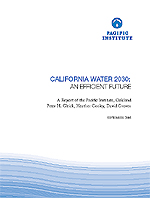California Water 2030: An Efficient Future

California Water 2030: An Efficient Future
Overview
What will the future hold for California’s water? Will resources dwindle, causing conflict and hardship, or will increased conservation measures and cooperation provide enough for all? While the future of water in California is uncertain, the prioritization of water-efficiency programs over traditional water management will be an essential component to successfully addressing water needs far into the state’s future.
This report details a “high-efficiency” water scenario for the state that would provide multiple benefits. It finds that through smart technology, strong management, and appropriate rates and incentives, California could cut water use by 20 percent over 25 years while satisfying a growing population, maintaining a healthy agricultural sector, and supporting a vibrant economy.
Key Findings
California water planners regularly prepare projections of supply and demand as part of the California Water Plan process, but these projections have never included a vision of a truly water-efficient future, where California’s environmental, economic, and social water needs are met with smart technology, strong management, and appropriate rates and incentives. Some of the water saved could be rededicated to agricultural production elsewhere in the state, support new urban and industrial activities and jobs, and restore California’s stressed rivers, groundwater aquifers, and wetlands.
Key findings include:
- A water-efficient future for California is possible.
- The Pacific Institute High Efficiency scenario shows that water use in 2030 could be 20 percent below 2000 levels, even with a growing population and a healthy economy.
- A water-efficient future is achievable, with no new inventions or serious hardships.
- Implementing serious efficiency improvements requires actions on the part of legislators, water managers, water districts and agencies, farmers, corporations, and all individuals.
- The sooner such actions are taken, the easier the transition to an efficient future will be.
Recommendations include:
- Eliminate pricing policies that subsidize the inefficient use of water.
- Expand efforts to promote the use of water-efficient technologies and practices, in both the urban and agricultural sectors.
- Provide legislative, regulatory, and administrative support to those water transfers that improve water-use efficiency while promoting the overall well-being of rural communities.
- Improve integration of land and water planning.
Resources

